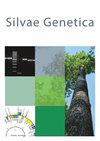Gene-Targeted markers to assess genetic diversity and population structure within Tunisian Phoenix dactylifera L. cultivars
IF 1
4区 农林科学
Q3 FORESTRY
引用次数: 4
Abstract
Abstract Genetic variability in date palm genotypes collected from different regions of southern Tunisia was analyzed using a Start Codon Targeted (SCoT) marker system. Thirty-one accessions collected from three locations were investigated. One hundred and nine amplicons were produced among which 84 % were polymorphic. The PIC value and the Rp values testified of the efficiency of used primers. The percentage of polymorphic loci (Pp) varied from 44.57 to 83.70 %, Nei‘s gene diversity (H) from 0.175 to 0.273 with a mean of 0.228, and Shannon‘s information index (I) values ranging from 0.257 to 0.409 with an average value of 0.338 were illustrated. The Tunisian date palm populations exhibited high genetic differentiation (GST = 0.319) and gene flow (Nm = 1.063). The AMOVA analysis presented 70 % of the variation within the population and 30 % of the variation between them. Phylogenetic analysis and the Bayesian clustering approach also revealed high genetic variation among genetic variants with a net divergence of the wild insular population of Kerkennah from other cultivars. The present investigation suggests the effectiveness of the SCoT marker system to estimate the genetic diversity of Phoenix dactylifera genotypes.利用基因靶向标记评价突尼斯凤头草品种的遗传多样性和群体结构
摘要采用起始密码子靶向(Start Codon targeting, SCoT)标记系统分析了突尼斯南部不同地区枣椰树基因型的遗传变异。调查了从三个地点收集的31份材料。产生109个扩增子,其中84%为多态扩增子。PIC值和Rp值证明了所使用引物的效率。多态性位点百分比(Pp)变化范围为44.57 ~ 83.70%,Nei基因多样性(H)变化范围为0.175 ~ 0.273,平均为0.228,Shannon信息指数(I)变化范围为0.257 ~ 0.409,平均为0.338。突尼斯枣椰树居群具有较高的遗传分化(GST = 0.319)和基因流(Nm = 1.063)。AMOVA分析显示70%的群体内变异和30%的群体间变异。系统发育分析和贝叶斯聚类方法还显示,各遗传变异之间存在较高的遗传变异,野生岛居群与其他品种存在净分化。本研究表明,SCoT标记系统可以有效地估计凤爪草基因型的遗传多样性。
本文章由计算机程序翻译,如有差异,请以英文原文为准。
求助全文
约1分钟内获得全文
求助全文
来源期刊

Silvae Genetica
农林科学-林学
CiteScore
2.20
自引率
10.00%
发文量
10
审稿时长
3 months
期刊介绍:
Silvae Genetica is an international peer reviewed journal with more than 65 year tradition and experience in all fields of theoretical and applied Forest Genetics and Tree breeding. It continues "Zeitschrift für Forstgenetik und Forstpflanzenzüchtung" (Journal of Forest Genetics and Forest Tree Breeding) founded by W. LANGNER in 1951.
 求助内容:
求助内容: 应助结果提醒方式:
应助结果提醒方式:


